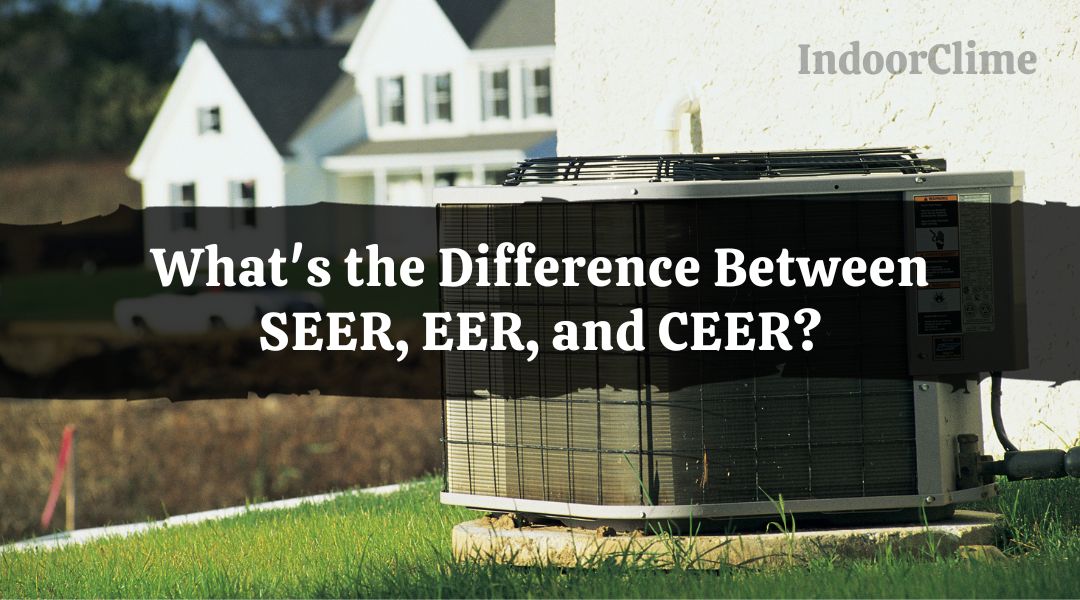Energy efficiency ratings for air conditioning units include EER, CEER, and SEER. The heating and cooling business compares systems using a set of efficiency ratings. EER ratings are assigned to some systems. Others have SEER scores, while others have CEER scores.
Let’s break down the differences between EER, SEER, and CEER in air conditioners in simple words. These energy-efficiency ratings are based on BTU/hr output at various AC settings (Standy Mode, Speed 1, Speed 2, Speed 3, etc.).
What is SEER, EER, and CEER?
The SEER (Seasonal Energy Efficiency Ratio) was developed to address the shortcomings of the EER ranking. The Energy Efficiency Ratio or the EER is the oldest air conditioner efficiency rating, dating back over 40 years. The Combined Energy Efficiency Ratio, or the CEER, is a standard for window air conditioners that measures the unit’s combined efficiency in both standby and cooling mode.
SEER (SEASONAL ENERGY EFFICIENCY RATIO)

The cooling efficiency of an air conditioner is measured in SEER throughout a cooling season. The SEER is calculated using a 28°C typical July temperature. A central air conditioner’s efficiency is often measured in SEER.
The SEER rating indicates how well a cooling system will perform throughout a season. The SEER rating shows how efficient the system is. It understands that performance varies depending on the operating environment.
Even while a SEER provides a more accurate estimate of a system’s efficiency, it still suffers from the same issue as EER: test conditions and performance conditions vary across the country and at different times.
The SEER is typically found on air conditioner labeling for bigger, home-sized units. SEER efficiency ratings are also used in ductless air-source heat pumps.
A SEER is used to rate the efficiency of central air conditioning systems (SEER). The higher the SEER, the less electricity the system needs to function.
Here’s how to calculate a SEER:
1. By 1,000, multiply the number of BTUs/hour.
2. To get the total number of watts consumed in an average season, multiply the number used every hour by 1,000.
3. Divide the quantity of BTUs by the watts consumed in a season to get the SEER.
SEER can exceed 20 in high-efficiency whole-home versions, with less efficient models starting at 13. (the lowest SEER sold today).
EER (ENERGY EFFICIENCY RATIO)

The Energy Efficiency Ratio, or EER, measures how much cooling an air conditioner offers per unit of electrical energy consumed in a steady-state operation. EER measures a cooling system’s efficiency when the outside temperature is specific. The EER indicates how efficient the system is.
The cooling capacity in BTUs per hour (BTUH) is divided by the power input in watts to arrive at this figure. The EER is measured in BTUH/watts.
A conventional outdoor temperature of 95°F, an indoor air temperature of 80°F, and relative humidity of 50% are used to calculate an EER value. The ratio indicates how well a system will function under given circumstances.
The problem with EER is that it does not work in a controlled environment. EER ratings are typically found on window air conditioner labels and technical specifications.
CEER (COMBINED ENERGY EFFICIENCY RATIO)

CEER is a rating system introduced in 2014 to assess the energy efficiency of a window or room air conditioner. Both standby and cooling modes calculate the unit’s overall efficiency. It’s one of the essential energy-efficiency indicators for determining how much electricity an air conditioner will use.
CEER can help you determine how big an air conditioner you’ll need for a single room (i.e., BTU output). When looking at the CEER rating on the label, compare only other units with equivalent output levels.
In June 2014, the DOE (Department of Energy) adopted CEER as the new standard for rating window/room air conditioners. It considers both the energy used when the air conditioner operates and the standby power utilized when the unit is turned on but not in use.
The CEER is determined by dividing the recorded cooling output in BTU per hour by the average electrical energy input in Watts and standby/off-mode power consumption in Watts. The CEER rating determines how much BTU/hr our air conditioner produces based on the power it receives during regular operation and standby/off mode.
The critical thing to remember is that CEER considers standby/off-mode and normal operation power usage.
How Do the Three Ratings Differ?

- SEER is more popular in central air conditioners and heat pumps, but EER and CEER (just adopted in Canada) are more common in window air conditioners.
- Because SEER predicts energy efficiency throughout a cooling season, the air conditioner’s efficiency is assessed at 18.3 to 40 degrees Celsius temperatures. EER, on the other hand, measures energy efficiency at a single temperature, 35°C.
- At different temperatures, SEER is calculated. It is concerned with the beginning and halting of the air conditioner. EER accounts for the AC operating because it is measured at a high temperature (steady-state).
- SEER figures are higher than EER numbers for any particular air conditioner model.
- EER ratings are especially essential in extremely hot regions since they evaluate an air conditioner constantly working – or, in technical terms, “under full load.”
- Because it considers the unit’s beginning and stopping, SEER ratings are essential in locations with a wide range of midsummer temperatures.
- In the past, the EER was the only way to determine the efficiency of cooling systems. Later, as an alternative to EER, SEER was introduced. People nowadays evaluate cooling systems based on their Seasonal Energy Efficient Rating.
- Because of the unpredictability of weather conditions, the Energy Efficiency Ratio can be assessed directly, whereas projections can only establish Seasonal Energy Efficient Ratings.
What Is a Good CEER Rating For Air Conditioner?

The CEER grade reliably identifies which air conditioner is the most energy-efficient. For the same level of cooling power, the higher the CEER rating, the less electricity you’ll have to pay. A high-efficiency air conditioner (CEER) can save significant energy.
Let’s look at the energy use of two 14,000 BTU window air conditioners with differing SEER ratings to see what we mean:
A unit with a high CEER rating is the LG LW1517IVSM 14,000 BTU, which has a 14.7 CEER rating. Thus, the estimated annual electricity expenditure is $68.
A cheaper 14,000 BTU unit with a low 9 CEER rating is an example of a standard CEER-rated unit. The estimated annual electricity bill is $111.
As can be seen, the difference in electricity consumption between the high CEER and low CEER air conditioners is $43/year, and this is for the very minimal air conditioner usage.
Therefore, the cost difference would be more than $100 per year in practice.
Window air conditioners can now easily last ten years or longer. Compared to the low CEER-rated air conditioner, the higher CEER unit will use ten years x $43/year = $430 less electricity. Here, you may find out how long air conditioners last.
That’s a significant difference, and it’s only the beginning. For example, if a high CEER unit costs $500 and a low CEER unit costs $200, the more expensive high CEER unit still makes far more financial sense.
How Is the CEER Rating Calculated?
The CEER rating is essential since it incorporates standby/off-mode energy consumption. Therefore, DOE conducted a statistical investigation of how much power room air conditioners consume in standby and off mode to generate the CEER rating calculation.
Here are the figures that appear to come from this investigation:
A. 1.4 Watts is the average standby power input.
B. CEER assumes 750 hours of operation (100 percent BTU output).
C. CEER assumes a standby time of 5115 hours.
The significant difference between the EER and the CEER ratings is the 5115 hours of standby mode, which uses 1.4 W of energy. The transformer provides the majority of the 1.4 Watts of electricity.
We can put the formula like this:
CEER Rating: 100% BTU + Standby/Off-Mode BTU output.
What Is a Good EER Rating For an AC Unit?
Suppose you’re wondering what an EER rating for an air conditioner should be 8.5 or higher. The appliance with a higher rating is more energy efficient.
Also, keep an eye out for the ENERGY STAR label. It means that the air conditioner requires 10% less energy to run.
What is Considered a Good SEER Rating?

A decent SEER rating is between 13 and 21. This, however, is dependent on the climate conditions in your area. The US Department of Energy released a list of SEER ratings by geographic location.
The greater the number, the more energy-efficient the system’s SEER ratings. However, the exact number of a “good” rating is debatable. SEER ratings of 8 or 9 are typical for air conditioners manufactured during the last ten years. This is adequate but not effective.
Most states now have laws requiring all new air conditioners to have a SEER rating of 13 or 14, a conventional, well-rounded efficiency rating. However, you can obtain as high as 25 SEER in some circumstances.
Because each home’s needs are unique, a single SEER rating does not apply to selecting a high-efficiency air conditioner. In addition, newer air conditioners, particularly Energy Star certified, are a continually changing technology that uses less energy than older models. As a result, regardless of the SEER rating, you save money on cooling your home.
While SEER 14 is adequate for most homes, high-efficiency systems are worth considering. Lower energy usage is connected with SEER ratings above 16, which equals less money spent on energy expenditures.
Replace an 8 SEER air conditioner or heat pump with a 16 SEER unit to save 50% on your energy bill. Government incentives and rebates are also available for high-efficiency air conditioning systems, which can help offset the update cost.
Is It Worth Getting a Higher SEER Rating?
The SEER number indicates how energy-efficient the unit is, resulting in cheaper bills. For example, when a 10 SEER AC unit is compared to a 20 SEER AC system, the latter will give twice the efficiency.
The 14 SEER system can be turned on or off. This implies that the fan and compressor constantly run at high speeds while cooling your home. Low and high rates are available on the two-stage compressor. When the system is turned on, it automatically shifts into low gear and works smoothly until it can no longer handle the load.
It then changes to high gear until the temperature stabilizes, downshifting to a more energy-efficient pace. The same may be said for the blower fan. Lower speeds can meet your cooling requirements around 80% of the time. Therefore, it will run more frequently.
This operation has two advantages: fewer hot/cold regions and lower humidity.
The longer-run duration allows for better mixing of existing and conditioned air, resulting in a more consistent temperature throughout the home. In addition, this longer run-time removes more water/humidity from the air, making your home more comfortable.
Starting the compressor uses more energy than running it at a constant pace. Because of its slower speed, the two-stage compressor uses far less energy than a regular AC unit.
Here are some benefits of a higher SEER rating:
1. Lower utility bills – High-efficiency systems with higher SEER ratings use less energy, resulting in less money spent on energy bills. You can save 50% on your energy bill by upgrading from an aging 8 SEER unit to a 16 SEER unit.
2. Incentives and Rebates – Numerous savings opportunities are available through government subsidies or manufacturer rebates. Taking advantage of these discounts, a high-efficiency system may cost about the same as a regular unit.
3. Environmental impact – High-efficiency systems consume less energy, emitting fewer greenhouse gases. Fewer fossil fuels are burnt when there is less power. This is beneficial to both your money and the environment.
4. Humidity – High-efficiency systems can assist in keeping the air at the desired temperature while removing moisture more effectively. Modulated systems cool the air more effectively by running longer cycles at lower pressures. Mold and other airborne problems might result from the air that cools too quickly without sufficient moisture removal.
Is a Lower EER Better?
A higher EER-rated air conditioner is more efficient and can provide more cooling for every watt of energy you supply. A unit with a high SEER but a low EER is efficient in mild and chilly weather but not so much in extreme heat. This is critical knowledge for homeowners in cold climates so you can choose a unit that best meets your needs!
Owning an air conditioner with a high EER rating benefits you and the environment! According to ENERGY STAR, if every room air conditioning unit sold was ENERGY STAR-certified, consumers would save over $350 million annually, and greenhouse gas emissions would be cut by 6 billion pounds.
Additionally, homeowners who install ENERGY STAR-rated air conditioners may be eligible for a $300 government tax credit. If your air conditioner is at your current home, which you must use as a principal residence, you can apply for this credit online through the IRS.
Environmental friendliness and reduced noise are two further benefits of higher SEER ratings. If you’re serious about turning green, an upgrade will bring you to your goals. High-efficiency air conditioners consume up to a third less energy than earlier models, allowing them to conserve even more natural resources.
Standard 14 SEER systems are substantially quieter than more efficient systems. This is useful when the outside unit must be adjacent to a bedroom window.
In addition, depending on the closeness of residences, certain HOAs or municipal ordinances may mandate you to utilize quieter equipment.






